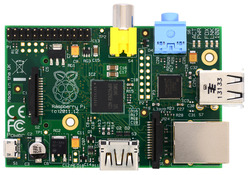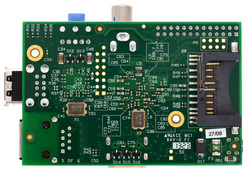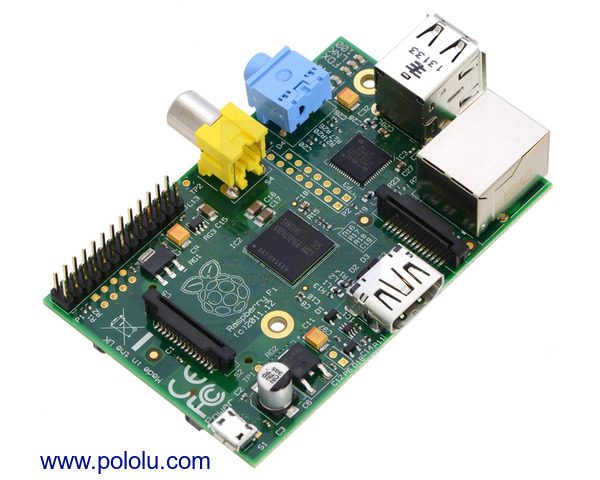Raspberry Pi Model B, Revision 2.0
The Raspberry Pi is a credit card-sized computer with an ARM processor that can run Linux. This item is the Raspberry Pi Model B, revision 2.0, which has 512 MB of RAM, an Ethernet port, HDMI output, RCA composite video output, audio output, two USB ports, and 0.1″-spaced pins that provide access to general purpose inputs and outputs (GPIO). The Raspberry Pi requires an SD card with an operating system on it (not included). The Raspberry Pi is very popular, with lots of example projects and information available online.
| Description | Specs (4) | Pictures (3) | Resources (9) | FAQs (0) | On the blog (5) | Distributors (0) |
|---|
Overview
The Raspberry Pi is a credit card-sized computer based on the BCM2835 system-on-chip (SoC), which includes an ARM11 processor and a powerful GPU. The Raspberry Pi supports various distributions of Linux including Debian, Fedora, and Arch Linux. This item is the Raspberry Pi Model B, revision 2.0.
The Raspberry Pi was designed by the Raspberry Pi Foundation in order to provide an affordable platform for experimentation and education in computer programming. The Raspberry Pi can be used for many of the things that a normal desktop PC does, including word-processing, spreadsheets, high-definition video, games, and programming. USB devices such as keyboards and mice can be connected via the board’s two USB ports. With its 0.1″-spaced GPIO header and small size, the Raspberry Pi also works as a programmable controller in a wide variety of robotics and electronics applications. Over two million Raspberry Pis have been sold, and lots of resources for the Raspberry Pi are available online.
 |
Raspberry Pi Model B, Revision 2.0, top view. |
|---|
 |
Raspberry Pi Model B, Revision 2.0, bottom view. |
|---|
Features
- 512 MB of RAM
- Ethernet port
- Two USB ports
- Two video output options: HDMI or composite
- 3.5 mm audio output jack
- 26-pin GPIO header with 0.1″-spaced male pins that are compatible with our 2×13 stackable female headers and the female ends of our premium jumper wires.
What you will need
To use the Raspberry Pi, you will need a few additional things that are not included:
- A 5 V power source with a micro USB connector. We recommend this 5 VDC 1 A wall power adapter and a USB A-to-Micro-B cable.
- An SD card with an operating system on it, which also serves as the main storage for the device.
- Input and output devices, such as a keyboard and monitor.
You might also consider getting a case to house and protect your Raspberry Pi, such as the Adafruit Pi Case – Enclosure for Raspberry Pi Model A or B.
While the Raspberry Pi is powered from a 5 V supply, it operates at a 3.3 V logic level and its pins are not 5V-tolerant. Connecting higher voltages, like 5 V, directly to an I/O pin could damage the board. We recommend you use something like our bidirectional logic level shifter to interface this board with 5V systems.
For more information about the Raspberry Pi, see the technical, help and resource documents on the Raspberry Pi website.
Comparison between Raspberry Pi Model B, revision 2.0 and Model B+
The Raspberry Pi Model B+ is a newer, reimagined version of the Raspberry Pi Model B, revision 2.0. Both of these boards support HDMI, Ethernet, component video output, and audio output; however, on the Raspberry Pi Model B+, analog video and audio have been consolidated to a single four-pole 3.5 mm jack. This 3.5 mm jack also has it’s own dedicated low-noise power supply for improved audio. Many other components are in slightly different locations on the two boards but are present on both, such as the camera connector, display connector, and micro USB port.
Along with using a microSD card instead of a standard SD like the model B, revision 2.0, the Raspberry Pi Model B+ has two additional USB ports (for a total of four) and 14 additional pins on the GPIO expansion header (for a total of 40). The first 26 pins on the Raspberry Pi Model B+ expansion header are identical to the 26 pins available on the Raspberry Pi Model B, revision 2.0. The Raspberry Pi Model B+ also features switching regulators (instead of linear regulators), which helps reduce its power consumption by 0.5 W to 1 W compared to the Raspberry Pi Model B, revision 2.0.
The table below shows some key features and specifications of these two Raspberry Pi boards to help you choose the right one for your application.
 Raspberry Pi Model A+ 512MB |
 Raspberry Pi Model B+ |
 Raspberry Pi 2 Model B |
 Raspberry Pi 3 Model B |
 Raspberry Pi 3 Model B+ |
|
|---|---|---|---|---|---|
| CPU: | BCM2835 | BCM2836 | BCM2837 | BCM2837B0 | |
| CPU cores: | 1 | 4 | |||
| CPU speed: | 700 MHz | 900 MHz | 1.2 GHz | 1.4 GHz | |
| RAM: | 512 MB | 512 MB | 1 GB | ||
| Ethernet: | No | Yes | |||
| WiFi: | No | 2.4 GHz 802.11n | 2.4 GHz 5 GHz 802.11b/g/n/ac | ||
| Bluetooth: | No | 4.1 | 4.2 | ||
| Bluetooth Low Energy: | No | Yes | |||
| HDMI: | Yes | ||||
| Analog video: | Yes1 | ||||
| SD socket: | microSD | ||||
| Onboard regulators: | switching | ||||
| Expansion header pins: | 40 | ||||
| USB ports: | 1 | 4 | |||
| Mounting holes: | 4 | ||||
| Dimensions2: | 2.5″ × 2.2″ × 0.47″ | 3.35″ × 2.2″ × 0.8″ | |||
| Weight3: | 23 g | 42 g | 50 g | ||
1 Audio and analog video provided by a single four-pole 3.5 mm jack. This 3.5 mm jack also has its own dedicated low-noise power supply for improved audio.
2 Length and width measurements are for the PCB only; several of the connectors extend past the edge of the board.
3 Weight does not include microSD cards.
Raspberry Pi is a trademark of the Raspberry Pi Foundation.














